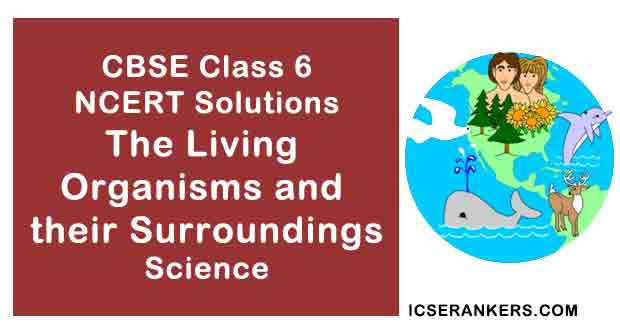NCERT Solutions for Chapter 9 Living Organisms and their Surroundings Class 6 Science
Short Notes for Class 6 Science Chapter 9 Living Organisms and their Surroundings
The surroundings where plants and animals live, is called
their habitat. Several kinds of plants and animals may share the same habitat. The
presence of specific features and habits, which enable a plant or an animal to
live in a particular habitat, is called adaptation. There are many types of
habitats, however, these may be broadly grouped as terrestrial (on the land)
and aquatic (in water). There is a wide
variety of organisms present in different habitats. Plants, animals and
microorganisms together constitute biotic components. Rocks, soil, air, water,
light and temperature are some of the abiotic components of our surroundings. Living
things have certain common characteristics — they need food, they respire and,
excrete, respond to their environment, reproduce, grow and show movement.

Chapter Name | Living Organisms and their Surroundings NCERT Solutions |
Class | CBSE Class 6 |
Textbook Name | Science |
Related Readings |
|
Question 1: What is a habitat?
Answer
Habitat means a dwelling place (a home). The surroundings where organisms live is called a habitat. The organisms depend for their food, water, air, shelter and other needs on their habitat. Several kinds of plants and animals may share the same habitat.
Question 2: How are cactus adapted to survive in a desert?
Answer
Cactus lose very little water through transpiration. The leaves in cactus plants are present in the shape of spines. This helps in reducing loss of water from the leaves through transpiration. Its stem is converted into a leaf-like structure. Photosynthesis in these plants is usually carried out by the stems. The stem is also covered with a thick waxy layer, which helps to retain water. Cactus plants have roots that go very deep into the soil for absorbing water.

Question 3: Fill up the blanks
(a) The presence of specific features, which enable a plant or an animal to live in a particular habitat, is called _______.
(b) The habitats of the plants and animals that live on land are called _______ habitat.
(c) The habitats of plants and animals that live in water are called _______ habitat.
(d) Soil, water and air are the _______ factors of a habitat.
(e) Changes in our surroundings that make us respond to them, are called_______.
Answer
(a) The presence of specific features, which enable a plant or an animal to live in a particular habitat, is called adaptation.
(b) The habitats of the plants and animals that live on land are called terrestrial habitat.
(c) The habitats of plants and animals that live in water are called aquatic habitat.
(d) Soil, water and air are the abiotic factors of a habitat.
(e) Changes in our surroundings that make us respond to them, are called stimuli.
Question 4: Which of the things in the following list are non-living?
Plough, Mushroom, Sewing machine, Radio, Boat, Water hyacinth, Earthworm
Answer
Non-living things: Plough, Sewing machine, Radio, Boat.
Question 5: Give an example of a non-living thing, which shows any two characteristics of living things.
Answer
Bus and Machine both shows movement and consume energy.
Question 6: Which of the non-living things listed below, were once part of a living thing?
Butter, Leather, Soil, Wool, Electric bulb, Cooking oil, Salt, Apple, Rubber
Answer
Butter, Leather, Wool, Cooking oil, Apple, Rubber.
Question 7: List the common characteristics of the living things.
Answer
Living things have certain common characteristics — they need food, they respire and, excrete, respond to their environment, reproduce, grow and show movement.
Question 8: Explain, why speed is important for survival in the grasslands for animals that live there.
(Hint: There are few trees or places for animals to hide in grasslands habitats.)
Answer
In the grassland there are less number of trees and places to hide. The animals are vulnerable to predators (e.g. lions, tigers, wolves etc.). They can only survive and escape if they can run faster. Therefore speed is important for survival in the grasslands for animals (e.g. deer) that live there.

